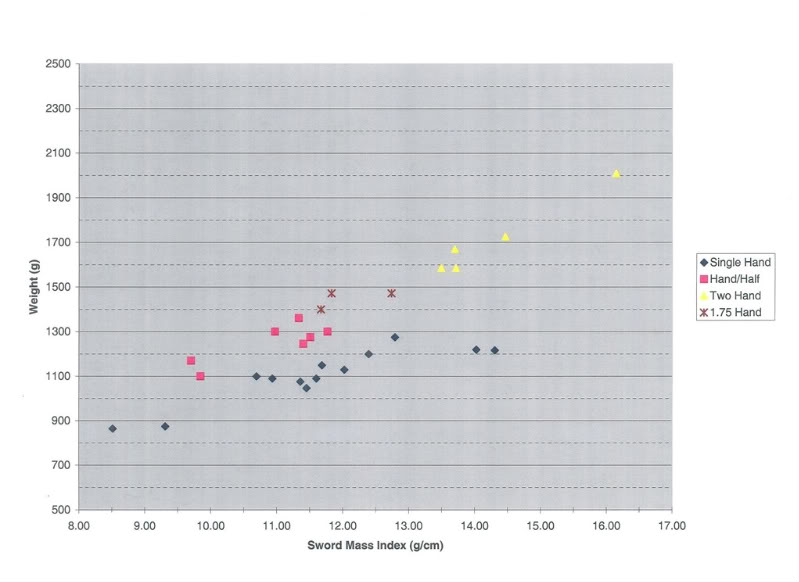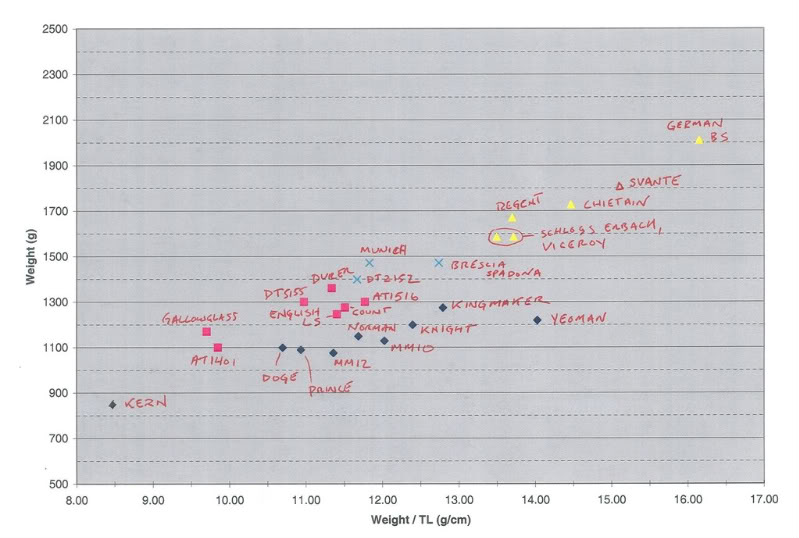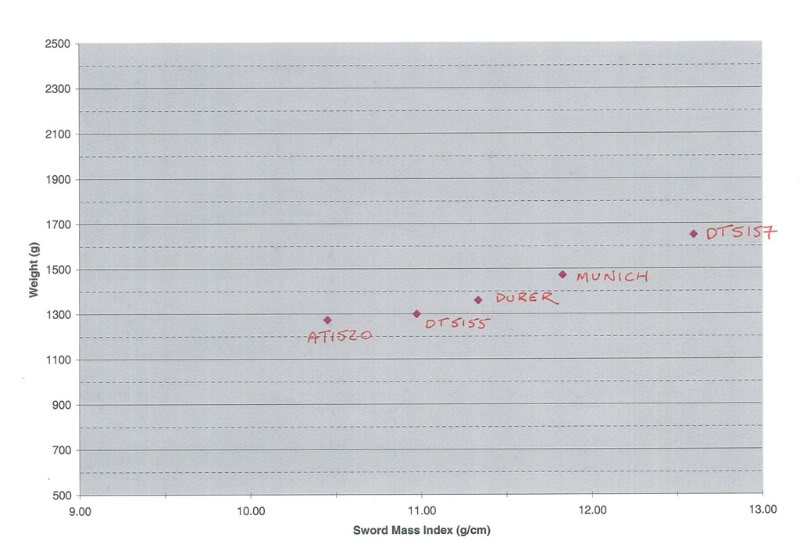Over the years I have been a bit frustrated by an inability to adequately describe swords in terms of their feel and handling characteristics, even to other knowledgeable folks who have a fair experience with blades in the hand. We (including myself) often revert to describing our swords like we do wines, using such terms as "light and lively" or "hits with authority", or "flows easily" etc etc.
Hence, I have been on a Arthurian quest (probably hopeless) for a better method to quickly and adequately classify or describe swords based on measureable characteristics. Now, I do understand that in the end this approach has its limits as so many variables can affect the handling of a sword. But a lot of things in life are complex, that doesn't mean (to me anyway) that we shouldn't try to improve our understanding, even if it is just a tiny step forward. So please take this posting in that spirit..........
I have struggled with various numbers and ratios involving everything from lengths to POBs to weights to tapers and so on and so forth. I have written computer programs, looked at pivot points you name it, I am an engineer so I have done it. But because I can't go to every blade show and I don't live anywhere near Seattle, Minneapolis, or New Glarus,what I really was hoping for was not a global system of categorization, but something that would allow me to readily get a feel for a sword based on readily available measurements, particularly for comparing a sword against its peers, i.e. swords of a similar type and size.
At the end of the day after crunching a lot of numbers and a lot of ratios and doing a lot of correlations back and forth, this way, that way, upside down, inverted (when all else fails invert, always invert), and turned around, having handled 20+ swords in the production market the past 4,5 years, I found myself back at the beginning (isn't that often the way, no matter where you go there you are) and finally decided that KISS was the best approach so I began tabulating a simple ratio of a sword's total weight to its total length (in grams and cm). I call this simple ratio the Sword's Mass Index. Yes I know that sounds stupidly simple, but when charted against the swords total weight, you do get this general pattern in which you can assess where a particular sword falls, and you now have a benchmark number that you can use to compare two swords of similar type.
Now before I go any further, I just want to define a few things. First, a single hand sword in my book is simply that, a sword with a hilt of 18 cm or less which has room for really only one hand. Once you get above that, now you are in hand and a half or two hand territory as to really be able to put two hands on the sword generally requires 22 cm or more. Most hand and a half bastard swords have tangs that are 24 cm or longer. Second, I am a relatively big guy, but for me, a sword needs to be under 1300 grams in weight to be a single hand sword. Above that, its pretty hard to work the sword accurately with one hand let alone wield it for any length of time. And if you study swords you see that historically, most single hand swords are less than 1300g. Now, as for the breakpoint between bastard swords and true two handers, that is a bit subjective as well, but for me, once the weight gets above about 1550g, generally I find that I need two hands on the sword at all times. This will vary by person. Hand a half swords, meanwhile can be wielded in one hand or two because of their longer hilt/tang lengths, and their relatively light weight. In addition, for me there is also this grey zone (which I call for lack of a better term 1.75 hands) where the boundary between a two hand sword and a hand a half sword gets a little fuzzy, that is swords weighing 1350-1550 grams, with a mass index above 12.
So without further rambling, here is a chart of the MI for a bunch of readily available swords, many of which have been discussed here or have been reviewed here, from Gus Trim, Arms and Armour, Albion, Del Tin and a few others:

What you see on my chart above are swords classified into single hand swords by virtue of their hilt/tang length, swords that are two hand swords because of their weight, and swords that are hand and a half swords because they are light enough to be wielded with one hand but are long enough to be held with two hands.
Just to orient things a bit - the sword on the lowermost left is the Albion Kern at 865 grams, and in the upper right that is the A&A German Bastard Sword weighing in at 2010 grams:

Now, remember, in the chart the variables are correlated, that is, weight of the sword is part of the mass index so you would expect to see a general trend in a chart like this, but what it does show is that despite all of the different sword types, there still are general trends across the chart, that is, there is an inherent "zone" in which good functional swords tend to fall into when it comes to weight and length irrespective of blade cross sections and types, and despite the autocorrelation there is still a fair amount of variability across the chart due to factors such as blade geometry (size, cross section and tapers), tang size, and hilting components. But generally, in my experience, I think I am willing, albeit with some reluctance, to state the following:
Most other things being equal (blade type, blade size), swords with a lower MI tend to feel more "lively", and are easier to control at full speed than swords that are higher in MI
Again, most things being equal, swords with a higher MI tend to strike harder and are usually more forgiving when cutting, and are less fussy about edge alignment than peers with a lower MI.
Although it depends to great extent on the POB, for swords with similar MI, even just a slight increase in total weight (30-60 grams) can have a drastic effect on the way the swords "feel". (this is why re-hilting a sword with new components can make or break a sword's handling characteristics sometimes)
Most of the bastard swords I personally prefer, despite having different blade types and lengths, tend to fall into a specific region on this chart. Which is why if nothing else, I have found this chart useful. It tells me if a sword is in my ballpark or not.
I believe that when it comes to two hand swords, there is, for lack of a better term, what I call a "central tendency" line along which swords that feel completely balanced in my two hands tend to fall on, e.g. Brescia Spadona, Svante, GBS. Even at its high weight the GBS feels not much heavier to me than the Svante.......I believe that is because the additional weight of the sword is appropriately balanced for its size and weight
But back to basics. The MI is really not that meaningful when comparing across sword types. But here is an example which I found useful for comparing Type XVIIIa swords

You can see how the four swords compare. The Munich and Del Tin 5157 have a slightly longer blades but the other three all have 36-36.5 inch blades. Yet because of the blade geometry and tapers and hilt lengths, the swords do have a bit of variability in how they feel and I think the MI clearly shows the trend between the swords. What this does is place eth swords into a context, although it is only the first step in their evaluation
I could go on to talk about complex hilted swords and why they tend to fall on the chart where they do as well as why swords like the big wide Type XIVs fall where they do, but I have typed enough for now.
To wrap up, as usual your mileage may vary, and all comments are welcome including "Thom thats the stupidest thing I have ever seen on myArmoury". tr